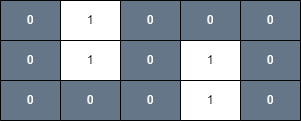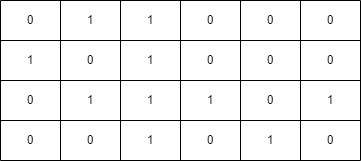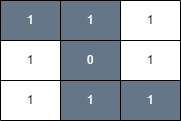Welcome to Subscribe On Youtube
3286. Find a Safe Walk Through a Grid
Description
You are given an m x n binary matrix grid and an integer health.
You start on the upper-left corner (0, 0) and would like to get to the lower-right corner (m - 1, n - 1).
You can move up, down, left, or right from one cell to another adjacent cell as long as your health remains positive.
Cells (i, j) with grid[i][j] = 1 are considered unsafe and reduce your health by 1.
Return true if you can reach the final cell with a health value of 1 or more, and false otherwise.
Example 1:
Input: grid = [[0,1,0,0,0],[0,1,0,1,0],[0,0,0,1,0]], health = 1
Output: true
Explanation:
The final cell can be reached safely by walking along the gray cells below.

Example 2:
Input: grid = [[0,1,1,0,0,0],[1,0,1,0,0,0],[0,1,1,1,0,1],[0,0,1,0,1,0]], health = 3
Output: false
Explanation:
A minimum of 4 health points is needed to reach the final cell safely.

Example 3:
Input: grid = [[1,1,1],[1,0,1],[1,1,1]], health = 5
Output: true
Explanation:
The final cell can be reached safely by walking along the gray cells below.

Any path that does not go through the cell (1, 1) is unsafe since your health will drop to 0 when reaching the final cell.
Constraints:
m == grid.lengthn == grid[i].length1 <= m, n <= 502 <= m * n1 <= health <= m + ngrid[i][j]is either 0 or 1.
Solutions
Solution 1: BFS
We define a 2D array $\textit{dist}$, where $\textit{dist}[i][j]$ represents the minimum health value required to reach position $(i, j)$ from the top-left corner. Initially, we set $\textit{dist}[0][0]$ to $\textit{grid}[0][0]$ and add $(0, 0)$ to the queue $\textit{q}$.
Then, we continuously take elements $(x, y)$ from the queue and try to move in four directions. If we move to a valid position $(nx, ny)$ and the health value required to move from $(x, y)$ to $(nx, ny)$ is smaller, we update $\textit{dist}[nx][ny] = \textit{dist}[x][y] + \textit{grid}[nx][ny]$ and add $(nx, ny)$ to the queue $\textit{q}$.
Finally, when the queue is empty, we obtain $\textit{dist}[m-1][n-1]$, which is the minimum health value required to reach the bottom-right corner from the top-left corner. If this value is less than $\textit{health}$, then we can reach the bottom-right corner; otherwise, we cannot.
The time complexity is $O(m \times n)$, and the space complexity is $O(m \times n)$. Here, $m$ and $n$ are the number of rows and columns of the grid, respectively.
-
class Solution { public boolean findSafeWalk(List<List<Integer>> grid, int health) { int m = grid.size(); int n = grid.get(0).size(); int[][] dist = new int[m][n]; for (int[] row : dist) { Arrays.fill(row, Integer.MAX_VALUE); } dist[0][0] = grid.get(0).get(0); Deque<int[]> q = new ArrayDeque<>(); q.offer(new int[] {0, 0}); final int[] dirs = {-1, 0, 1, 0, -1}; while (!q.isEmpty()) { int[] curr = q.poll(); int x = curr[0], y = curr[1]; for (int i = 0; i < 4; i++) { int nx = x + dirs[i]; int ny = y + dirs[i + 1]; if (nx >= 0 && nx < m && ny >= 0 && ny < n && dist[nx][ny] > dist[x][y] + grid.get(nx).get(ny)) { dist[nx][ny] = dist[x][y] + grid.get(nx).get(ny); q.offer(new int[] {nx, ny}); } } } return dist[m - 1][n - 1] < health; } } -
class Solution { public: bool findSafeWalk(vector<vector<int>>& grid, int health) { int m = grid.size(); int n = grid[0].size(); vector<vector<int>> dist(m, vector<int>(n, INT_MAX)); dist[0][0] = grid[0][0]; queue<pair<int, int>> q; q.emplace(0, 0); int dirs[5] = {-1, 0, 1, 0, -1}; while (!q.empty()) { auto [x, y] = q.front(); q.pop(); for (int i = 0; i < 4; ++i) { int nx = x + dirs[i]; int ny = y + dirs[i + 1]; if (nx >= 0 && nx < m && ny >= 0 && ny < n && dist[nx][ny] > dist[x][y] + grid[nx][ny]) { dist[nx][ny] = dist[x][y] + grid[nx][ny]; q.emplace(nx, ny); } } } return dist[m - 1][n - 1] < health; } }; -
class Solution: def findSafeWalk(self, grid: List[List[int]], health: int) -> bool: m, n = len(grid), len(grid[0]) dist = [[inf] * n for _ in range(m)] dist[0][0] = grid[0][0] q = deque([(0, 0)]) dirs = (-1, 0, 1, 0, -1) while q: x, y = q.popleft() for a, b in pairwise(dirs): nx, ny = x + a, y + b if ( 0 <= nx < m and 0 <= ny < n and dist[nx][ny] > dist[x][y] + grid[nx][ny] ): dist[nx][ny] = dist[x][y] + grid[nx][ny] q.append((nx, ny)) return dist[-1][-1] < health -
func findSafeWalk(grid [][]int, health int) bool { m, n := len(grid), len(grid[0]) dist := make([][]int, m) for i := range dist { dist[i] = make([]int, n) for j := range dist[i] { dist[i][j] = math.MaxInt32 } } dist[0][0] = grid[0][0] q := [][2]int{ {0, 0} } dirs := []int{-1, 0, 1, 0, -1} for len(q) > 0 { curr := q[0] q = q[1:] x, y := curr[0], curr[1] for i := 0; i < 4; i++ { nx, ny := x+dirs[i], y+dirs[i+1] if nx >= 0 && nx < m && ny >= 0 && ny < n && dist[nx][ny] > dist[x][y]+grid[nx][ny] { dist[nx][ny] = dist[x][y] + grid[nx][ny] q = append(q, [2]int{nx, ny}) } } } return dist[m-1][n-1] < health } -
function findSafeWalk(grid: number[][], health: number): boolean { const m = grid.length; const n = grid[0].length; const dist: number[][] = Array.from({ length: m }, () => Array(n).fill(Infinity)); dist[0][0] = grid[0][0]; const q: [number, number][] = [[0, 0]]; const dirs = [-1, 0, 1, 0, -1]; while (q.length > 0) { const [x, y] = q.shift()!; for (let i = 0; i < 4; i++) { const nx = x + dirs[i]; const ny = y + dirs[i + 1]; if ( nx >= 0 && nx < m && ny >= 0 && ny < n && dist[nx][ny] > dist[x][y] + grid[nx][ny] ) { dist[nx][ny] = dist[x][y] + grid[nx][ny]; q.push([nx, ny]); } } } return dist[m - 1][n - 1] < health; }